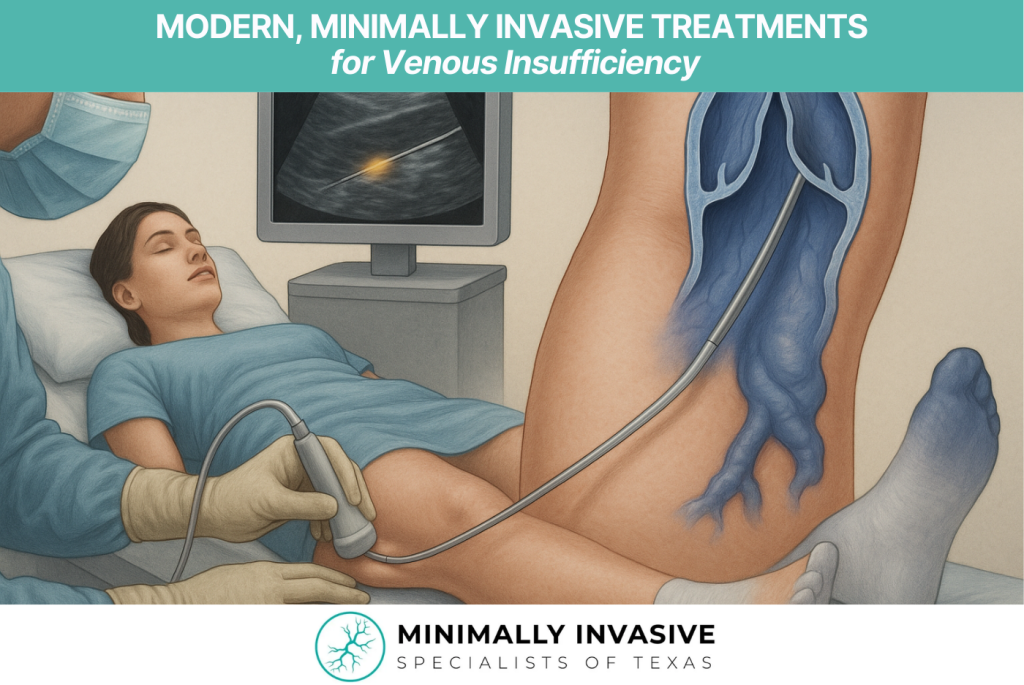
Understanding Venous Insufficiency
Venous insufficiency occurs when the valves in your leg veins stop working properly, making it harder for blood to flow back to the heart. Instead, blood pools in the legs, causing swelling, aching, and visible varicose veins. Untreated, it can lead to skin changes, ulcers, and chronic discomfort.
Traditional treatment once meant vein stripping surgery—a procedure requiring general anesthesia, hospital stays, and a long recovery. Today, advanced interventional radiology (IR) techniques provide faster, less invasive solutions.
Modern, Minimally Invasive IR Techniques
Interventional radiologists use imaging guidance and tiny catheters to treat diseased veins with remarkable precision. Key treatments include:
- Endovenous Laser Ablation (EVLA): Uses targeted laser energy to close faulty veins.
- Radiofrequency Ablation (RFA): Employs controlled heat to seal off problem veins.
- Ultrasound-Guided Sclerotherapy: Injects a specialized solution to collapse small varicose or spider veins.
- Venaseal™ Adhesive Closure: Seals the vein with a medical-grade adhesive—no heat, no tumescent anesthesia.
Benefits Compared to Traditional Surgery
- Outpatient Convenience: Most treatments are completed in under an hour.
- Minimal Downtime: Patients typically return to normal activity the same day.
- Cosmetic Results: Tiny punctures instead of large incisions mean minimal scarring.
- High Success Rates: Modern closure techniques show over 90% effectiveness.
Q&A: Your Top Questions Answered
Q: How do I know if I have venous insufficiency?
A: Symptoms include leg swelling, pain after standing, visible varicose or spider veins, and skin changes like discoloration or ulcers. A duplex ultrasound confirms the diagnosis.
Q: Is treatment painful?
A: Minimally invasive IR procedures are performed under local anesthesia or light sedation. Patients typically experience only mild discomfort, often described as a slight burning or tugging sensation.
Q: How long is the recovery?
A: Most patients walk immediately after the procedure and resume normal activities within 24 hours. Compression stockings may be recommended for a short period.
Q: Are results permanent?
A: Treated veins are permanently closed. While new veins can weaken over time, lifestyle changes and follow-up care greatly reduce recurrence.
Q: Will my insurance cover it?
A: If symptoms and diagnostic ultrasound show medical necessity, most insurance plans—including Medicare—cover these treatments.
Q: Why choose an interventional radiologist?
A: IR specialists use advanced imaging to precisely target problem veins, offering a higher level of accuracy and safety compared to traditional vein stripping.
Take the Next Step
If you experience leg pain, swelling, or visible veins, don’t wait. Early treatment prevents complications and improves quality of life.
Contact Minimally Invasive Specialists of Texas
4003 Woodlawn Ave, Pasadena, TX 77504
Phone: (832) 583-2246
Call today to schedule a comprehensive venous evaluation.
Key Takeaway
Modern interventional radiology techniques offer safer, quicker, and more effective treatment for venous insufficiency than traditional surgery. With minimal downtime and excellent results, you can regain comfort and confidence without the burden of invasive surgery.
